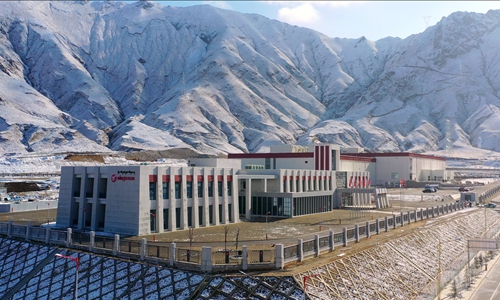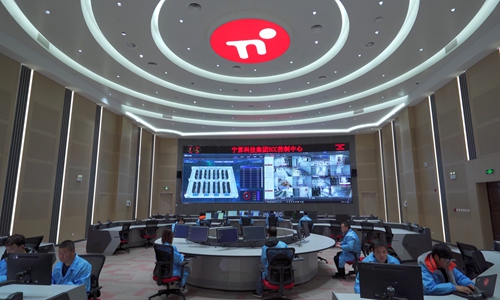SOURCE / INDUSTRIES
World's highest data center starts trial operation, serving as gateway to South Asia

A view of the cloud computing data center in the Liuwu New Area in Lhasa, capital of Southwest China's Tibet Autonomous Region Photo: Courtesy of Ningsuan Technologies
Standing at the Qinghai-Tibet plateau at over 3,000 meters above sea level, a cloud computing data center developed by a private technology firm has recently been put into trial operation, driving local economic growth while aiming at business expansion in South Asia.
Located in the Liuwu New Area in Lhasa, capital of Southwest China's Tibet Autonomous Region, the data center is so far the world's highest one. It covers 645,000 square meters with a total investment of 11.8 billion yuan ($1.67 billion). The phase-one project of the center was completed at the end of last year after nearly three years and has been put into trial operation.
Hu Xiao, general manager of Ningsuan Technologies, the operator of the center, told the Global Times on Tuesday that the whole project is expected to be completed by the end of 2026 on the condition that things go smoothly.
The outbreak of the coronavirus pandemic has disrupted normal economic activities and brought obstacles to the new data center as it has been actively seeking cooperation with enterprises in South Asian countries such as Nepal and Bangladesh under the framework of the Belt and Road Initiative (BRI).
"Our local employees in Nepal and Bangladesh are still trapped at home under the COVID-19 lockdown and their business contacts with potential customers have almost frozen," Hu said, adding that the firm is also in communication with domestic customers.
As an international offshore data center in Lhasa, the facility has high reliability, cost-effectiveness and energy-saving ability, which are competitive factors when competing with data centers in other provinces or regions in China, according to Hu.
Power usage effectiveness (PUE), a key ratio that describes how efficiently a computer data center uses energy, is much better in Tibet than in other places thanks to the cool air, as it means no air conditioning is needed. Computing cabinets usually needs air conditioners to cool the system, therefore consuming extra energy.
"Tibet's low average temperatures, clean air and abundant renewable energy for power generation are perfect for operating a big data center," Hu said.
Electricity consumption accounts for about 60 percent of the costs of keeping a big data center up and running.
The conditions in some South Asian countries in terms of building a data center are not yet ideal given the unstable electricity supply and hot and wet climate, he explained.
Despite the current difficulties in tapping into overseas markets, the Chinese firm is betting on the pivotal position of Tibet in the BRI and South Asia. Hu said he is confident in the facility's role in helping the South Asia region in the transformation toward digitalization.
"With the construction of the South Asian passages, many Chinese companies have crossed borders for investment and trade. The demand for data storage and processing is high, and most of these companies are considering upgrading or rebuilding their IT systems," Hu noted.
"A cloud storage center is like an off-shore data embassy for Chinese companies and their counterparts in South Asia," he said.

Staff of Ningsuan Technologies work at the cloud computing data center in the Liuwu New Area in Lhasa, capital of Southwest China's Tibet Autonomous Region. Photo: Courtesy of Ningsuan Technologies
Going digital
Tibet has in recent years witnessed rapid improvement in its communications infrastructure, which is not restricted to making phone calls but also brings business opportunities related to e-commerce, big data and cloud computing.
Based on the rapid growth of GDP, a golden opportunity has emerged to develop its digital economy based on big data, cloud computing and artificial intelligence. Plus, as China is going to speed up the development of its innovative technology sector with new investments in a series of infrastructure projects, Tibet's data center has a bright outlook, experts said.
The region saw GDP growth of 8.1 percent in 2019 on a yearly basis, above the national GDP growth rate of 6.1 percent, reaching nearly 170 billion yuan, official data showed
"When all the center's projects are completed and put into operation, it is expected to generate around 10 billion yuan of revenue for the local economy," Hu estimated.
Meanwhile, as the nation is pushing forward the construction of 5G networks, Tibet is not lagging behind.
The southwestern region plans to steadily promote the construction of 5G networks, and aims to achieve continuous coverage of cities and hotspot areas within three years. In 2020, it plans to build 2,000 5G base stations with an investment of 600 million yuan, according to the local communications authority.
In early 2019, Chinese telecom giant China Mobile launched the first 5G base station in Lhasa, laying the foundation for launching large-scale network tests in the region.
Yang Minghong, a professor at Sichuan University, told the Global Times on Tuesday that Tibet's economy is expected to realize rapid development - with digitalization playing a major driving role - that might not otherwise be realized via traditional industrial buildup.
The development path of Southwest China's Guizhou Province, one of China's most impoverished regions but now known as a "data valley," could be drawn on for Tibet, Yang said.
Big data has contributed more than 20 percent of Guizhou's economic growth and the province has led the country's GDP growth, with a rise of 8.3 percent in 2019.



